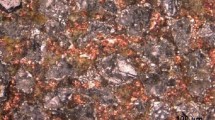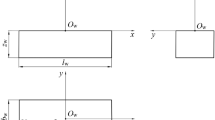Abstract
In the previous studies about grinding simulation, most of the abrasive grain models are simple geometries. The shape and size of the abrasive grain are varied, which will lead to the difference between the simulation and the reality. To make the virtual abrasive grains closer to reality, a stochastic polyhedral abrasive particle modeling method based on the ellipsoid tangent plane is proposed. Based on the ellipsoid model, the vertex coordinate equations of abrasive grain are derived. The 3D normal distribution is used to generate uniform random tangent points on the ellipsoid. The shape characteristics of normal virtual abrasive grains were analyzed, and the abnormal abrasive grains were corrected. The diameter of the minimum enclosed ball is used to calculate the equivalent diameter of the abrasive grain. According to the normal distribution, the abrasive grain sizes are scaled to the actual sizes. The coordinate transformation makes the abrasive grains more diverse. Finally, the influence of each input parameter on the virtual abrasive grain shapes is analyzed. And the shape distribution of actual and virtual abrasive grains is compared. The results show that the abrasive grain shape distribution can be effectively controlled through different generation strategies, and the model can simulate the actual abrasive grains effectively through the specific input strategy.


















Similar content being viewed by others
Data availability
Not applicable.
Abbreviations
- a, b, c :
-
Axial lengths of the ellipsoid
- a m, b m, c m :
-
Mean axial lengths of the ellipsoids
- a max :
-
Maximum axial lengths of the ellipsoid
- Δa, Δb, Δc :
-
Half of the axial length variation range
- A, B, C :
-
Coefficients of the tangent plane equation
- d :
-
Diameter of the abrasive grain
- d min, d max :
-
Minimum and maximum diameter of abrasive grains
- D :
-
Distance between the vertex and the origin
- D max :
-
Maximum distance between the vertex and the origin
- f :
-
Number of abrasive grain faces
- k :
-
k = Δa/am = Δb/bm = Δc/cm
- n :
-
Tangent plane number
- N :
-
Normal distribution
- r :
-
Distance between the tangent point and the origin
- h :
-
Height of the oriented bounding box
- l :
-
Length of the oriented bounding box
- w :
-
Width of the oriented bounding box
- x, y, z :
-
Coordinates in space
- x', y', z' :
-
Coordinates after coordinate transformation
- x o, y o, z o :
-
Coordinates of the abrasive grain center
- x P, y P, z P :
-
Coordinates of point P
- α x, α y, α z :
-
Rotation angles of the x-, y-, and z-axes
- ϕ :
-
Angle between the line from P to the origin and the positive direction of the z-axis
- γ :
-
Angle between the projection from point P to the origin and the positive x-axis
- λ :
-
Similarity ratio of the ellipsoid family
- μ :
-
Mean value of D/amax
- σ :
-
Standard deviation of D/amax
- μ d :
-
Mean value of d
- σ d :
-
Standard deviation of d
References
Malkin S (2008) Grinding technology: theory and application of machining with abrasives. Industrial Press Inc., New York
Agarwal S, Venkateswara Rao P (2010) Modeling and prediction of surface roughness in ceramic grinding. Int J Mach Tools Manuf 50:1065–1076. https://doi.org/10.1016/j.ijmachtools.2010.08.009
Oliveira JFG, Silva EJ, Gomes JJF, Klocke F, Friedrich D (2005) Analysis of grinding strategies applied to crankshaft manufacturing. CIRP Ann - Manuf Technol 54:269–272. https://doi.org/10.1016/S0007-8506(07)60100-0
Stephenson DJ, Sun X, Zervos C (2006) A study on ELID ultra precision grinding of optical glass with acoustic emission. Int J Mach Tools Manuf 46:1053–1063. https://doi.org/10.1016/j.ijmachtools.2005.08.013
Caggiano A, Teti R (2013) CBN grinding performance improvement in aircraft engine components manufacture. Procedia CIRP 9:109–114. https://doi.org/10.1016/j.procir.2013.06.177
Bhushan B (2013) Introduction to tribology. Wiley
Chen X, Rowe WB (2014) Analysis and simulation of the grinding process. Part I: generation of the grinding wheel surface. Eur Heart J 35:2264–2265. https://doi.org/10.1093/eurheartj/ehu271
Aurich JC, Kirsch B (2012) Kinematic simulation of high-performance grinding for analysis of chip parameters of single grains. CIRP J Manuf Sci Technol 5:164–174. https://doi.org/10.1016/j.cirpj.2012.07.004
Zhang Y, Li C, Ji H, Yang X, Yang M, Jia D, Zhang X, Li R, Wang J (2017) Analysis of grinding mechanics and improved predictive force model based on material-removal and plastic-stacking mechanisms. Int J Mach Tools Manuf 122:81–97. https://doi.org/10.1016/j.ijmachtools.2017.06.002
Liu P, Lin B, Yan S, Li Y, Wang B (2016) Numerical simulation and experimental validation of fixed abrasive grinding pad topography. Int J Adv Manuf Technol 83:1253–1264. https://doi.org/10.1007/s00170-015-7643-8
Wang S, Li C, Zhang D, Jia D, Zhang Y (2014) Modeling the operation of a common grinding wheel with nanoparticle jet flow minimal quantity lubrication. Int J Adv Manuf Technol 74:835–850. https://doi.org/10.1007/s00170-014-6032-z
Koshy P, Jain VK, Lal GK (1997) Stochastic simulation approach to modelling diamond wheel topography. Int J Mach Tools Manuf 37:751–761. https://doi.org/10.1016/S0890-6955(96)00086-7
Anandita S, Mote RG, Singh R (2017) Stochastic analysis of microgrinding tool topography and its role in surface generation. J Manuf Sci Eng Trans ASME 139:1–14. https://doi.org/10.1115/1.4038056
Wang X, Yu T, Dai Y, Shi Y, Wang W (2016) Kinematics modeling and simulating of grinding surface topography considering machining parameters and vibration characteristics. Int J Adv Manuf Technol 87:2459–2470. https://doi.org/10.1007/s00170-016-8660-y
Cooper WL, Lavine AS (2001) Grinding process size effect and kinematics numerical analysis. 122:59–69
Zhang X, Lei, Yao B, Feng W et al (2015) Modeling of a virtual grinding wheel based on random distribution of multi-grains and simulation of machine-process interaction. J Zhejiang Univ Sci A 16:874–884. https://doi.org/10.1631/jzus.A1400316
Liu W, Deng Z, Shang Y, Wan L (2019) Parametric evaluation and three-dimensional modelling for surface topography of grinding wheel. Int J Mech Sci 155:334–342. https://doi.org/10.1016/j.ijmecsci.2019.03.006
Li C, Sun L, Yang S, Zhang L, Wu C, Jiang Z (2018) Three-dimensional characterization and modeling of diamond electroplated grinding wheels. Int J Mech Sci 144:553–563. https://doi.org/10.1016/j.ijmecsci.2018.06.010
Li H, Li X, Chen Z, Liu X, Wang L, Rong Y (2018) The simulation of surface topography generation in multi-pass sanding processes through virtual belt and kinetics model. Int J Adv Manuf Technol 97:2125–2140. https://doi.org/10.1007/s00170-018-2004-z
Pinto FW, Vargas GE, Wegener K (2008) Simulation for optimizing grain pattern on engineered grinding tools. CIRP Ann - Manuf Technol 57:353–356. https://doi.org/10.1016/j.cirp.2008.03.069
De Pellegrin DV, Stachowiak GW (2005) Simulation of three-dimensional abrasive particles. Wear 258:208–216. https://doi.org/10.1016/j.wear.2004.09.040
Su C, Mi X, Wang F (2016) Research on the forming mechanism of ground surface based on multi abrasive grains cutting simulation. Proc 2016 IEEE 20th Int Conf Comput Support Coop Work Des CSCWD 2016 41–44. https://doi.org/10.1109/CSCWD.2016.7565960
Naderi S, Zhang M (2019) An integrated framework for modelling virtual 3D irregulate particulate mesostructure. Powder Technol 355:808–819. https://doi.org/10.1016/j.powtec.2019.07.089
Yan P, Zhang J, Fang Q, Zhang Y, Fan J (2016) 3D numerical modelling of solid particles with randomness in shape considering convexity and concavity. Powder Technol 301:131–140. https://doi.org/10.1016/j.powtec.2016.06.007
Hou ZB, Komanduri R (2003) On the mechanics of the grinding process—part I. Stochastic nature of the grinding process. Int J Mach Tools Manuf 43:1579–1593. https://doi.org/10.1016/S0890-6955(03)00186-X
Koshy P, Ives LK, Jahanmir S (1999) Simulation of diamond-ground surfaces. Int J Mach Tools Manuf 39:1451–1470. https://doi.org/10.1016/S0890-6955(99)00002-4
Blott SJ, Pye K (2008) Particle shape: a review and new methods of characterization and classification. Sedimentology 55:31–63. https://doi.org/10.1111/j.1365-3091.2007.00892.x
Luerkens DW, Beddow JK, Vetter AF (1982) Morphological fourier descriptors. Powder Technol 31:209–215. https://doi.org/10.1016/0032-5910(82)89006-2
Gotoh K, Finney JL (1975) Representation of the size and shape of a single particle. Powder Technol 12:125–130. https://doi.org/10.1016/0032-5910(75)80004-0
De Pellegrin DV, Stachowiak GW (2004) Evaluating the role of particle distribution and shape in two-body abrasion by statistical simulation. Tribol Int 37:255–270. https://doi.org/10.1016/j.triboint.2003.09.004
Funding
This work is supported by the Major State Basic Research Development Program of China [Grant No. 2017YFA0701200]; the Science and Technology Planning Project of Shenyang [Grant No. 18006001]; and the Fundamental Research Funds for the Central Universities [Grant No. N180306002].
Author information
Authors and Affiliations
Contributions
Hao Chen: conceptualization, methodology, investigation, data curation, visualization, writing—original draft
Ji Zhao: resources, supervision, project administration
Zhao Wang: investigation, writing—review and editing
Jinlong Dong: investigation, writing—review and editing
Tianbiao Yu: resources, supervision, project administration
Corresponding authors
Ethics declarations
Ethical approval
Not applicable.
Consent to participate
Not applicable.
Consent to publish
Not applicable.
Competing interests
The authors declare no competing interests.
Additional information
Publisher’s note
Springer Nature remains neutral with regard to jurisdictional claims in published maps and institutional affiliations.
Rights and permissions
About this article
Cite this article
Chen, H., Zhao, J., Wang, Z. et al. Modeling virtual abrasive grain based on random ellipsoid tangent plane. Int J Adv Manuf Technol 113, 2049–2064 (2021). https://doi.org/10.1007/s00170-021-06742-y
Received:
Accepted:
Published:
Issue Date:
DOI: https://doi.org/10.1007/s00170-021-06742-y




